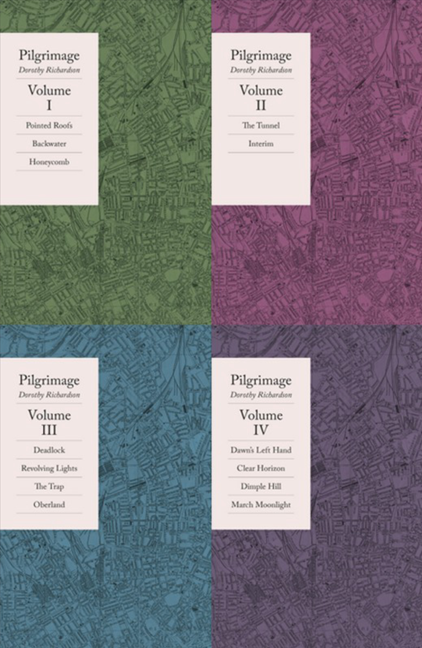 Image 1 of 1
Image 1 of 1


Pilgrimage by Dorothy Richardson
The first U.S. edition of Dorothy Richardson's challenging, insightful modernist classic, Pilgrimage. First published in 13 separate "chapter-volumes" between 1915 and 1967, Pilgrimage is unique in English literature. Unique, obviously, in its length, the closest challenger to Proust's A la recherche du temps perdu. Unique in its prose, the first to which the term "stream of consciousness" was applied (a term Richardson herself despised). Unique in its unapologetic insistence in showing us the world as seen through the eyes of Richardson's protagonist, Miriam Henderson, and Miriam alone. Unique in its embrace of a feminism rooted in Richardson's uncompromising belief that women have ideas, emotions, and rights not just equal to those of men but far less encumbered by the baggage of customs and manners.
As the novelist Jonathan Coe wrote of his first encounter with Pilgrimage, "Whether 'feminine' or not, the rhythms of Richardson's prose are unique, and when I began reading Pointed Roofs [the first chapter-volume] I had certainly not come across anything like them. As a critic for the avant garde film magazine Close Up, she was acutely sensitive to the potency of the moving image, and much of the descriptive writing in Pilgrimage consists of flickering, transient, seemingly random images, cut together to form montages that somehow carry an unexpected rightness."
This edition comprises four volumes totaling 1814 pages and is faithful to texts of the individual first editions, correcting numerous errors and amendments made in the 1938, 1967, and Virago Modern Classics editions.
The first U.S. edition of Dorothy Richardson's challenging, insightful modernist classic, Pilgrimage. First published in 13 separate "chapter-volumes" between 1915 and 1967, Pilgrimage is unique in English literature. Unique, obviously, in its length, the closest challenger to Proust's A la recherche du temps perdu. Unique in its prose, the first to which the term "stream of consciousness" was applied (a term Richardson herself despised). Unique in its unapologetic insistence in showing us the world as seen through the eyes of Richardson's protagonist, Miriam Henderson, and Miriam alone. Unique in its embrace of a feminism rooted in Richardson's uncompromising belief that women have ideas, emotions, and rights not just equal to those of men but far less encumbered by the baggage of customs and manners.
As the novelist Jonathan Coe wrote of his first encounter with Pilgrimage, "Whether 'feminine' or not, the rhythms of Richardson's prose are unique, and when I began reading Pointed Roofs [the first chapter-volume] I had certainly not come across anything like them. As a critic for the avant garde film magazine Close Up, she was acutely sensitive to the potency of the moving image, and much of the descriptive writing in Pilgrimage consists of flickering, transient, seemingly random images, cut together to form montages that somehow carry an unexpected rightness."
This edition comprises four volumes totaling 1814 pages and is faithful to texts of the individual first editions, correcting numerous errors and amendments made in the 1938, 1967, and Virago Modern Classics editions.